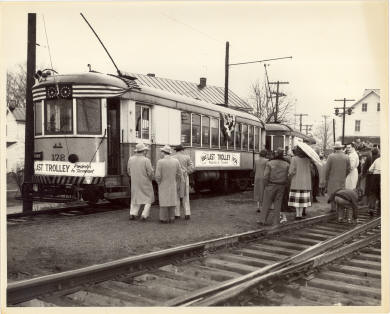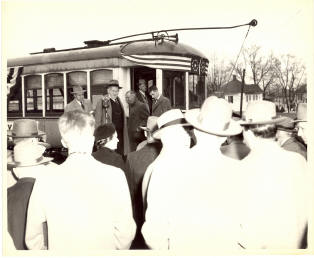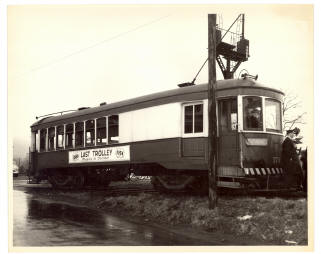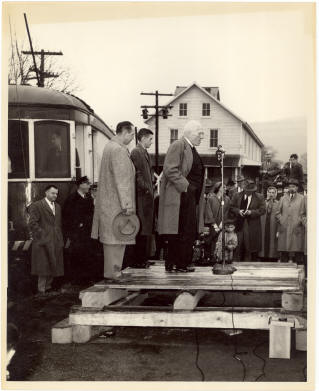James Rada, Jr.
Thurmont Dispatch
(10/18) At only 46 years old, the
Thurmont Trolley was the last of its kind.
The popularity of automobiles and buses and
the improvements in roads had evolved
transportation, leaving inter-urban trolleys,
like the Thurmont Trolley, a dinosaur nearing
extinction.
 “The last interurban passenger trolley in
Maryland, the Frederick-Thurmont line, will
roll into discard and the occasion can only
put mist in the eye and a sentimental ache in
the heart of the middle aged,” Betty Sullivan
wrote in The Frederick Post on February 20,
1954. “To them the clang, clang, clang of the
trolley turns thoughts backward in a time when
life still centered in the local community and
a twenty-mile journey was a venture abroad to
be undertaken with forethought and definite
plan.”
“The last interurban passenger trolley in
Maryland, the Frederick-Thurmont line, will
roll into discard and the occasion can only
put mist in the eye and a sentimental ache in
the heart of the middle aged,” Betty Sullivan
wrote in The Frederick Post on February 20,
1954. “To them the clang, clang, clang of the
trolley turns thoughts backward in a time when
life still centered in the local community and
a twenty-mile journey was a venture abroad to
be undertaken with forethought and definite
plan.”
The trolley had transported 3.8 million
riders around Frederick County in 1920, but by
1940, that number was down to 500,000 riders.
“Gradually the bus and the passenger car
snipped away at trolley patronage, gradually
lines were discontinued, until the 17-mile
stretch from Frederick to Thurmont was the
only link in the state between two such urban
points,” Sullivan wrote. “Despite competition
this trolley kept its faithful friends and
some 60 commuters will use it until the final
day.”
 The
final day was February 20, 1954.
The
final day was February 20, 1954.
“After February 20, the Frederick-Thurmont
route will be converted into a bus line for
passengers and a regular railroad freight car
will be substituted onto the tracks to handle
freight,” reported The Hagerstown Daily Mail.
Once the ending of service was announced,
business on the trolley picked up so much that
a Sunday service was added for the first time
in years.
“One of the trolleys was chartered last
Sunday by the Washington Railway Historical
Society. On Saturday, so many passengers
showed up that a double header was required
for one round trip,” reported The Hagerstown
Daily Mail.
The Thurmont Trolley began life in 1886
when the Monocacy Valley Railroad Company
built a steam train line to haul iron from
Catoctin Furnace to Thurmont and the Western
Maryland Railroad. Two years later, the
Northern Railroad Company extended the line to
Frederick. In 1908, the lines became electric.
Finally in 1913, the Northern Railway Company
connected to the Washington County railroad
lines and the Hagerstown and Frederick Railway
Company was formed.
The Thurmont Trolley was unique because it
operated on tracks that were of regular width
for trains. Trolleys generally used narrower
rails.
 The two final trolleys left the car barn
(the present-day office of the Frederick
News-Post) with about 100 invited guests on a
Saturday morning that was drizzling rain. Each
passenger had a souvenir ticket punched in
regulation fashion. Flags and bunting were
hung along the route and photographers
followed the progress of the trolley, snapping
pictures.
The two final trolleys left the car barn
(the present-day office of the Frederick
News-Post) with about 100 invited guests on a
Saturday morning that was drizzling rain. Each
passenger had a souvenir ticket punched in
regulation fashion. Flags and bunting were
hung along the route and photographers
followed the progress of the trolley, snapping
pictures.
“Uncounted hundreds of rolls of film were
consumed during the event, by dozens of people
who turned out at every hamlet along the
trolley’s route, and by the passengers. Some
persons brought along movie cameras. One
unidentified man drove from Allentown, Pa., in
time to accompany the trolley to Thurmont and
back, via auto. Driving along the roads that
came closest to the trolley’s tracks, he made
an endless series of moving picture scents of
the vehicle in progress, because his hobby
consists of taking pictures of trolley cars,”
reported The Hagerstown Daily Mail.
Though the outside of the cars were
decorated very little had changed inside them.
One report noted that the leather hand straps
riders could hold onto were as good as new.
This was because the cars were rarely crowded
enough for them to be used. “But the rest of
the trolley equipment has an antiquaited
atmosphere. The no-spitting sign is yellow
with ade. Some of the advertising signs had
been there since the days of World War Two,
because they referred to beer that would still
lead the field after peace came,” reported The
Hagerstown Daily Mail.
During the ride, the former riders
recounted their stories of the trolley.
The ride to Thurmont took a little more than
an hour where they passengers were greeted by
a crowd of about 100 people. Thurmont Mayor
Ray Weddle, Jr.; Potomac Edison President R.
Paul Smith and Frederick Mayor Donald Rice
made short remarks to the gathering because of
the rain.
 On
the return trip, The Hagerstown Daily Mail
noted, “Passengers sang ‘I’ve Been Working on
the Railroad’ and ‘Auld Lang Syne’ and stops
were made at two points—Yellow Springs and
Lewistown.”
On
the return trip, The Hagerstown Daily Mail
noted, “Passengers sang ‘I’ve Been Working on
the Railroad’ and ‘Auld Lang Syne’ and stops
were made at two points—Yellow Springs and
Lewistown.”
“Officially it ended at 1:30 Saturday
afternoon when a hundred invited guests
climbed down from Potomac Edison Co. veteran
cars No. 171 and No. 172 in the East Patrick
Street carbarn after completing the 34-mile
round trip to Thurmont that had many of the
aspects of a big parade,” reported The
Frederick Post.
When the trolleys returned, buses took the
passengers to a luncheon at the Francis Scott
Key Hotel. During the luncheon Smith said,
“Progress eventually overtakes all of man’s
previous works. This is true in existence of
the trolley car, as it was when it first came
into being. The passing of the trolley closes,
except in our memories and to those
contributions to our lives both socially and
economically, a great era of expansion and
development.”
Though the trolley service ended, its
impact on the region is still felt. Because of
the power demands for electric trolleys, their
existence necessitated the creation of a
high-capacity power generating plant. It’s
this power network that grew profitable while
the trolleys it powered became less
profitable. The Hagerstown and Frederick
Railway became the Potomac Edison Company in
1923.
“Oddly, that was the trolley’s salvation.
By the early 1930s, the rail network was
economically obsolete and parts were abandoned
by Potomac Edison, including half of the
Frederick-Hagerstown ‘main line.’ But the big
and wealthy utility seemingly could not face
discarding its onetime parent entirely, and
three routes survived into the late 1940s,”
Herbert Harwood Jr. wrote in an article for
the Maryland Department of Energy about the
Hagerstown and Frederick Railway.
The trolley also had a small role in the
building of Interstate 70. The Hagerstown
Morning Herald reported on February, 27, 1954,
the one of the Thurmont trolleys would be
loaned to the Maryland State Roads Commission.
“The State Roads Commission will use it for
office purposes at Frederick. Work is being
rushed on the completion of a new dual highway
between Frederick and Baltimore, and the
officials who are overseeing its completion
will set up their desks and records inside the
sturdily constructed trolley car,” the
newspaper reported.
Freight service continued on the line until
1958 when the tracks were finally removed.